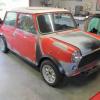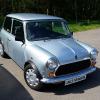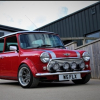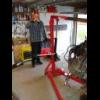Bhaha,,, no, not rude at all. Good info in fact.
This is a sheet my fastener supplier passed on to me a few years back,while is is pretty much along the lines of what F1L8EY has said, the last paragraph is why I said what I did above;-
Nyloc is a registered trade name of Forest Fasteners.
A Nylock nut resists turning. Usually nuts are free spinning, but Nylock nuts have a plastic patch that causes resistance to nut turning. This resistance is called "prevailing torque". Prevailing torque is the torque required to turn the nut. None of the prevailing torque goes toward tightening the bolt.
Nylock nuts fall within a group of nuts called 'lock nuts" Lock nuts come in all types and sizes. Typically there are the "Nylock" or elastic stop nuts, and the "all-metal" lock nuts.
The rule of thumb is to add the prevailing torque to the torque value when applying torque to a Nylock nut. This is because the prevailing torque doesn't contribute to bolt tightening. It is just friction that needs to be overcome.
For example, a Grade 5 1/4-28 bolt in tension lubricated zinc plating, with a torque of 10.5 lb. ft. produces a clamping load of 2,511 pounds.
If we use a use a Nylock nut that takes 2 lb. ft. of torque to turn, then 2 lb. ft. of torque is used in turning the nut leaving only 8.5 lb. ft. for bolt tension. Our clamping load is reduced to 2,009 pounds.
If, however, we take our original torque of 10.5 and add the 2 that the Nylock requires and set our torque wrench to 12.5, our clamp load is 2,511 pounds. The same as it was without the nylock.
You can use your torque wrench to measure Nylock nut torque and then add this value to the bolt's required torque.
Prevailing torque calculation should be done with your nut and your bolt using your thread lubricant. Published prevailing torque charts may give you an idea of how much torque is used up by the nut's locking feature, but in actual conditions, the results will vary. There is an interaction between the bolt threads, nut locking feature, and the thread lubricant (whether liquid or plating) that makes each prevailing torque calculation unique.
I hope that I don't appear Rude in presenting this view.
<Edit: To correctly 'torque a fastener with a torque wrench, as stated in the above and for good reason, lubricaant needs to be used to overcome the friction created between the threads of the fasteners and also the face to material friction, otherwise what are we 'torquing'? Are we doing it to a desired 'friction' value or to stretch the fastener? From my own experience when lub is added to a Nyloc, much (and in some cases, all) of it's self locking feature has gone. I think the only way of setting fastener 'tightness' when using self locking fasteners is by measuring the stretch of the fastener.
Out of curiousity, In the Aircraft Industry, do they state to 'Torque' Dry or Lubed? And what are the materials being fastened together?>
Edited by Moke Spider, 14 January 2015 - 06:47 AM.





















